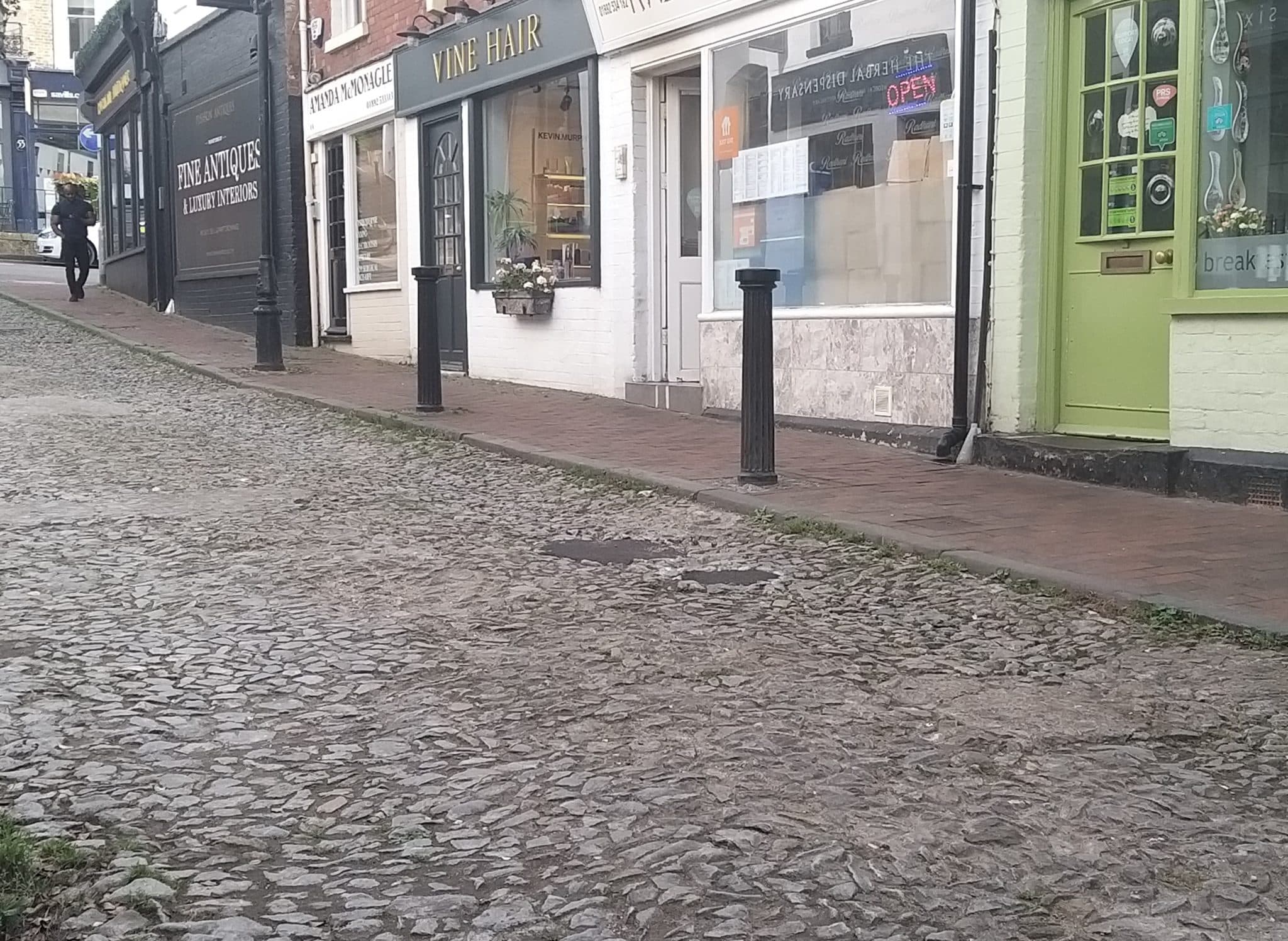TRADERS in a Tunbridge Wells street are suffering the consequences of a decision made in the 1980s to resurface the road with cobbles. This has left an uneven, patched surface in the town centre’s Castle Street, which is a hazard to pedestrians.
According to old photographs, the cobbles in Castle Street were laid in 1987. Not only is there little history to the surface, but frequent holes form and it is hard to maintain, the landlady of Cassidy’s pub Zoe Rolandsen told the Times.
“With the last [pothole], they poured tarmac over the loose cobbles which were sticking up. It needs to be done [properly], one way or another – either with tarmac or cobbles. It needs to be fixed,” Ms Rolandsen explained.
Eman Correia of the Casa Café told the Times: “The tarmac starts coming out – they just throw tarmac in the hole.”
And he criticised the effect on pedestrians, saying: “People avoid coming here because of the state of the street. They trip and fall over.
Darren Bird of Castle Street Barbers said: “I’ve seen many people trip on the cobbles over the 15 years I’ve been here.”
It’s mainly the pedestrians who struggle,” added Ms Rolandsen. “We’re a pub, so we get quite a few girls in high heels, but it’s mainly the pensioners who have fallen.”
Anne Musker, of the Tunbridge Wells & District Access Group, also criticised the street surface, for both visually and physically impaired people.
“The ruts in the cobbles are not clearly outlined to help road users such as cyclists and visually impaired people to avoid them,” she told the Times.
Regarding those in wheelchairs, she said: “They will feel every bump. People are entitled to go out and about without being in pain!”
Meanwhile, years of repairs have made the road surface higher, to the point that water running down the street can slop onto the pavement, especially on the Cassidy’s side, added Ms Rolandsen.
Although Castle Street has not flooded for three years, previous major floods – notably in 2015, 2017 and 2020 – hit the historic pub hard, and now, she said, “We’re no longer insured for flooding.”
With the road also sloping sideways, the drains on the ‘high’ side are not able to work effectively, said Ms Rolandsen, calling for a complete replacement of the road.
“It needs digging down to what it was, and [then] flattening.”
Yet it seems there is little hope of a comprehensive fix, or even changing the road surface.
A Kent County Council (KCC) spokesman stressed that safety was a priority and that it repaired problems when reported, prioritising and planning resurfacing according to risk, as set out in the Highways Asset Management Plan (HAMP).
But he said: “There are currently no plans to resurface Castle Street, Tunbridge Wells, but we will continue to listen to the concerns of people in the area and address them in line with the HAMP where appropriate.
“KCC has not received any personal injury claims relating to this particular stretch of road in the last five years.”
Of the recent roadworks (in May), South East Water’s Head of Operations in Kent Nick Bell said: “We’re sorry to hear that the reinstatement of the road surface has caused upset among traders in the area.”
However, he stressed: “In the event of reinstating the road, South East Water and our contractors will do their utmost to match and replace all excavations with like-for-like materials. This is done by laying the original materials back in place or sourcing materials that best match the original aesthetics of the area.”
The street is inside the Business Improvement District (BID), where businesses with a rateable value above £15,000 pay a levy to the Royal Tunbridge Wells Together (BID).
Confirming to the Times that only Cassidy’s and Lago di Como were eligible for the levy, BID CEO Alex Green said: “We naturally focus our energies on BID members but we believe in a thriving business environment and are keen to ensure a more general thriving business community for all.”
He said the organisation was working on a project with Tunbridge Wells Borough Council to design and then invest in an upgrade project of the public realm of the High Street.
“This project will consider Castle Street and potentially look to restrict the traffic for the street, creating a safer setting for pedestrians and businesses, potentially allowing for more outdoor tables and chairs,” Mr Green said.
BID was also looking to invest in enhanced street lighting for Castle Street, he added.
“Simultaneously we raise street maintenance issues as we become aware of them with the relevant authorities and will continue to support and advocate for any other improvements that will support to enhance the town.”








